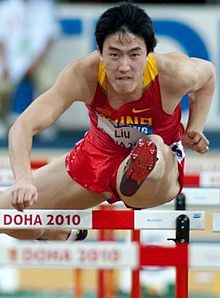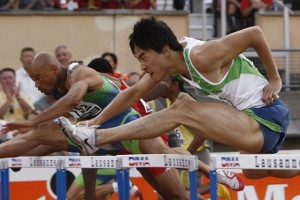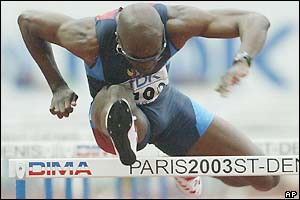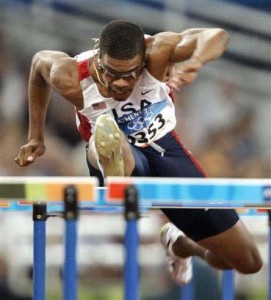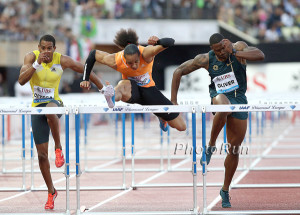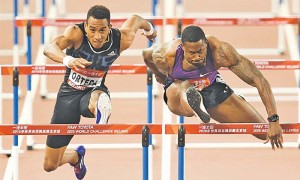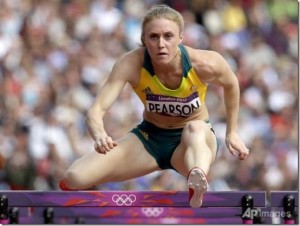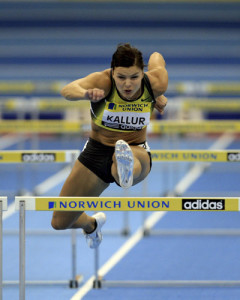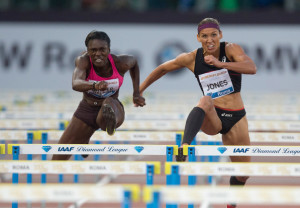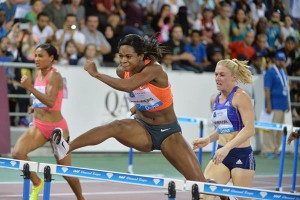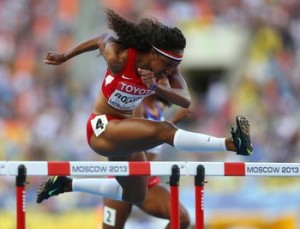Keeping the Elbows in
In the hurdles, arm carriage goes a long way in determining an athlete’s ability to increase speed off of hurdles and to maintain speed in the later stages of a race. While the details of the optimal way to carry the arms will vary from athlete to athlete, and can get very complicated, there are a few simple things that can be applied to hurdlers at all levels to ensure that the arms do more good than harm.
[am4show not_have=’p1;’]
…Want to read the rest?
Subscribe Now!
[/am4show][am4guest]
…Want to read the rest?
Subscribe Now!
[/am4guest][am4show have=’p1;’]
One of the basics I teach my hurdlers is, “When in doubt, keep the elbows in.” That’s because many beginning hurdlers, and even some highly advanced ones, have issues with their arms getting away from their body – particularly the trail arm. Usually this happens because the elbows open up too widely, causing a side-to-side swinging motion that can create all kinds of balance issues in the hips and shouders.
Now, with the lead arm, the way it finishes on the back side of the hurdle reveals whether or not it rose into position effectively on the front side of the hurdle. Many hurdlers do open up the elbow of the lead arm. Those with an efficient lead arm raise the hand straight up, so opening the elbow serves the dual purpose of providing the trail leg with room to pull through and of providing a forceful push back to the ground. Those who have an inefficient lead arm allow the hand to cross the body, pulling the elbow and hand of the trail arm far away from the body.
Generally, female hurdlers can get away with arm-related mistakes more so than males simply because the hurdles are lower. But there have been male hurdlers with wide elbows and trail arms that pull away from them who have still been able to run very fast times.
Let’s take a look at the arm carriage of some of the world’s best hurdlers – present and a few from the past – and see what we can learn.
Since all conversations about hurdling technique are going to involve Liu Xiang, let’s go ahead and start there:
In the above photo, Liu demonstrates exquisite positioning of the arms. Both elbows are bent, with the lead arm punching down. The elbow of trail arm is tight and close to the body, with the hand of that arm positioned on the hip. Such arm carriage minimizes (or should I say eliminates) lateral movement in the lane, keeping Liu on a straight path toward the next hurdle.
In the photo above, from Liu’s 2006 world record race, we can see the arms from a side angle. Again, the elbow of the trail arm is cocked straight back, with the hand positioned on the hip. The lead arm is punching downward, mirroring the action of the lead leg.
The above photo features Allen Johnson, another technical master in the men’s high hurdles. While there are minor differences between Johnson’s arms and Liu’s arms, the fundamentals are the same. Johnson’s trail arm is wider than Liu’s, and the hand is a little bit removed from the hip. The elbow of the lead arm, meanwhile, is raised higher. However, this raising of the elbow is for the forceful effect of the punchdown, as I mentioned earlier. Notice that Johnson’s lead arm is punching in a downward motion, not in a sideways motion. So, by the time he lands, the lead arm will be in perfect position to sprint off the hurdle, as will the trail arm.
The above photo features Terrence Trammell, another long-time outstanding American hurdler who, like Johnson, was coached by Curtis Frye for a decent chunk of his career. Let’s take a look first at Trammell’s lead arm and compare it Johnson’s. What you’ll notice is that both elbows open up, but Trammell’s raises to the point where it is higher than the shoulder, whereas Johnson’s is parallel to the shoulder. You can see that his thumb is pointing down, and the palm of his hand is facing slightly more outward than Johnson’s. As a result, where Johnson’s hand will punch down, Trammell’s is more of a threat to pull outward, away from his body, which will widen his trail leg and put strain on the groin of his trail leg. He will land with his hips a little sideways, and will need to realign his hips when he touches down. While the difference between Johnson and Trammell is almost imperceptible, the minor nuances add up when you’re talking about a miniscule flaw carried over ten hurdles against top-flight competition.
The photo above features three of todays top hurdlers, Orlando Ortega of Cuba, Pascal Martinot-Lagarde of France, and David Oliver of the USA. Ortega, in the middle, is taking off. His lead arm elbow is tight, but you can see that his trail arm elbow has opened up and the arm is getting away from him. Preferably, the elbow would be bent at an angle that would enable the hand to hug the hip, as in the photos of Liu and Johnson above. Martinot-Lagarde, meanwhile, seems to have pretty wild arms in this photo. And yes, his elbows do typically flair out pretty fair. I do believe that if he tightens up his arms, he will become a consistent sub-13 hurdler. Oliver, like Ortega, looks very efficient with the lead arm, keeping the elbow tight and the hand moving in an up-and-down motion. But, again like Ortega, his trail arm elbow has opened up a bit, causing the hand to get away from the body. Oliver is generally very efficient with the arms – more so than this photo indicates.
Here is another photo featuring Ortega and Oliver. Here you can see that Ortega, who has now left the ground and is attacking the hurdle, has pulled his trail arm too far behind him, countering the positive effect of his very efficient lead arm. Were he to bend the elbow and put the hand on the back pocket, he could reduce his airtime. Oliver, meanwhile, looks extremely efficient with both arms in this photo.
Now let’s take a look at some of the women hurdlers.
Just as all technical discussions in the men’s hurdlers include Liu Xiang, in the women’s hurdlers they must include Sally Pearson. In the photo above, Pearson demonstrates an arm carriage very similar to that of Liu’s, to the point where you have to figure she must have studied Liu’s style very closely in the process of developing her own. Both elbows stay very close to the body, the arms are moving straight up and down. You won’t find another hurdler, male or female, with better balance than Pearson.
If you’re kicking it old school with the female hurdlers, then you have to take a look at Susanna Kallur. What I don’t like about her style is the straight-leg lead, as opposed to Pearson, who keeps her lead leg bent on top of the hurdle. But in regards to the arms, Kallur is excellent. Like Johnson, she opens up the elbow of the lead arm, but the hand doesn’t go across the body, so the hand can punch straight down. The trail arm is exactly like Liu’s in the first photo of this article. The elbow goes straight back, and the hand is at the level of the mid-section. The arms are keeping everything moving forward.
In the photo above we have two of the top American hurdlers over the past decade – Dawn Harper-Nelson and Lolo Jones. If we’re looking at the arms, it is evident whey Harper-Nelson has been more consistent at a higher level of excellence over the same period of time. Harper-Nelson in this photo looks very similar to Kallur, with both elbows in tight and the lead arm punching down. The hand of her trail arm isn’t locked in as tightly as Kallur’s, but for me, as long as the elbow stays bent and stays close to the body, the hand is going to be in good position. As for Jones, the lead arm is moving across her body, as evidenced by the fact that her trail arm is moving away from her body, with the elbow straightening up way too much. I think that part of the reason that Jones tends to get too crowded in races – besides her height – is because her arms keep her in the air too long.
The above photo features this year’s new phenom in the women’s 100m hurdles, Jasmin Stowers. Stowers tend to use the karate chop lead arm, where it crosses her body, but with the thumb still pointing up, so that the arm comes back down in a slicing motion as opposed to swinging widely. The trail arm, meanwhile, stays tucked in close to the body, with the elbow bent. This karate chop style, in my opinion, is something that guys couldn’t get away with. It would just cause too much twisting. But women – especially taller women like Stowers – can get away with it with no problem. Harper-Nelson used to employ this style, but tightened it up about three years ago. I would like to see Stowers do the same as she continues to refine her technique.
Brianna Rollins, above, is another karate chopper. Sometimes, as in this photo, it’s a bit too much, as her trail arm swings up very high. However, both elbows are bent and tight, so even though her arms are going across her body, they are moving, not hanging. Rollins serves as proof that if the elbows stay tight, even if there are other noticeable flaws in the arm carriage, a hurdler can still speed through the race with relative ease of motion.
[/am4show]
